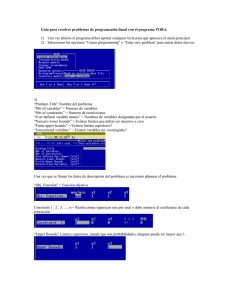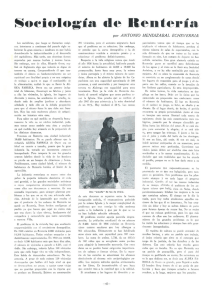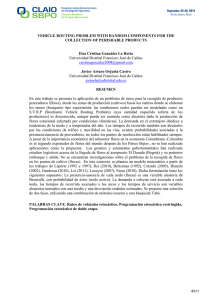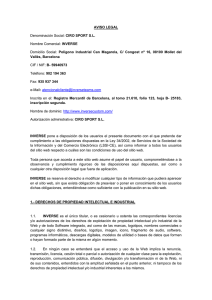ANA4 - INVERSE PROBLEMS: THEORY, METHODS AND
Anuncio
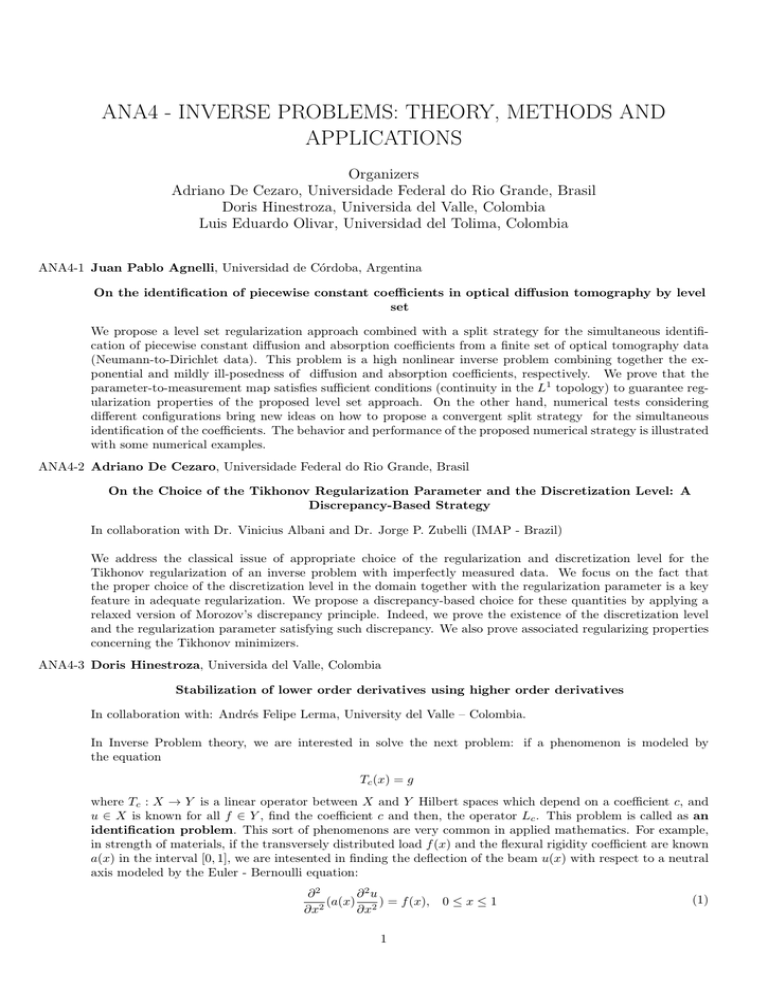
ANA4 - INVERSE PROBLEMS: THEORY, METHODS AND APPLICATIONS Organizers Adriano De Cezaro, Universidade Federal do Rio Grande, Brasil Doris Hinestroza, Universida del Valle, Colombia Luis Eduardo Olivar, Universidad del Tolima, Colombia ANA4-1 Juan Pablo Agnelli, Universidad de Córdoba, Argentina On the identification of piecewise constant coefficients in optical diffusion tomography by level set We propose a level set regularization approach combined with a split strategy for the simultaneous identification of piecewise constant diffusion and absorption coefficients from a finite set of optical tomography data (Neumann-to-Dirichlet data). This problem is a high nonlinear inverse problem combining together the exponential and mildly ill-posedness of diffusion and absorption coefficients, respectively. We prove that the parameter-to-measurement map satisfies sufficient conditions (continuity in the L1 topology) to guarantee regularization properties of the proposed level set approach. On the other hand, numerical tests considering different configurations bring new ideas on how to propose a convergent split strategy for the simultaneous identification of the coefficients. The behavior and performance of the proposed numerical strategy is illustrated with some numerical examples. ANA4-2 Adriano De Cezaro, Universidade Federal do Rio Grande, Brasil On the Choice of the Tikhonov Regularization Parameter and the Discretization Level: A Discrepancy-Based Strategy In collaboration with Dr. Vinicius Albani and Dr. Jorge P. Zubelli (IMAP - Brazil) We address the classical issue of appropriate choice of the regularization and discretization level for the Tikhonov regularization of an inverse problem with imperfectly measured data. We focus on the fact that the proper choice of the discretization level in the domain together with the regularization parameter is a key feature in adequate regularization. We propose a discrepancy-based choice for these quantities by applying a relaxed version of Morozov’s discrepancy principle. Indeed, we prove the existence of the discretization level and the regularization parameter satisfying such discrepancy. We also prove associated regularizing properties concerning the Tikhonov minimizers. ANA4-3 Doris Hinestroza, Universida del Valle, Colombia Stabilization of lower order derivatives using higher order derivatives In collaboration with: Andrés Felipe Lerma, University del Valle – Colombia. In Inverse Problem theory, we are interested in solve the next problem: if a phenomenon is modeled by the equation Tc (x) = g where Tc : X → Y is a linear operator between X and Y Hilbert spaces which depend on a coefficient c, and u ∈ X is known for all f ∈ Y , find the coefficient c and then, the operator Lc . This problem is called as an identification problem. This sort of phenomenons are very common in applied mathematics. For example, in strength of materials, if the transversely distributed load f (x) and the flexural rigidity coefficient are known a(x) in the interval [0, 1], we are intesented in finding the deflection of the beam u(x) with respect to a neutral axis modeled by the Euler - Bernoulli equation: ∂2u ∂2 (a(x) 2 ) = f (x), 0 ≤ x ≤ 1 2 ∂x ∂x 1 (1) Since the inverse problem perspective, we are interested in the problem of find the coefficient a(x) if u(x) and f (x) are known. However, to solve it, under some conditions, it is necessary to calculate a second order derivative and it is well know that the problem of calculating a derivative is an ill-posed problem. That is, when u(x) is known with small noise, the derivative u0 (x) can not be obtained without big noise. Many different techniques have been presented before to stabilize the first order derivative: mollification, iterative methods, Tikhonov regularization. In this talk, we will present a new method using the reconstruction of the higer order derivatives: given a function u(x) and using Landweber iteration method, we will reconstruct the fourth order derivative and using integration of that function, we will obtain the second order derivative. We will show that it can be a better technique to approach the derivative under certain conditions. Besides, we will present estimatives, generalize the method to stabilize lower order derivatives if higher order derivatives are known and finally, we will present some examples of interest. ANA4-4 Alejandro Marañon, Universidad de los Andes, Colombia Retos y Perspectivas de los Problemas Inversos en la Caracterización Dinámica de Materiales La caracterización del comportamiento dinámico de materiales juega un papel muy importante en las industrias automotriz, aeroespacial y naval, entre otras. Comúnmente, en estas industrias se utilizan simulaciones numéricas, en la forma de paquetes comerciales de elementos finitos explı́citos, para el diseño de componentes y estructuras los cuales pueden estar sometidos a altas tasas de deformación unitaria. Estas simulaciones requieren de modelos constitutivos de los materiales, y sus parámetros asociados, para predecir el proceso de deformación de dichos componentes y estructuras. En consecuencia, los ingenieros que trabajan en este tipo de simulaciones necesitan estimar los parámetros del modelo constitutivo del material a partir de técnicas experimentales no estandarizadas, tales como el ensayo de Taylor, la barra divida de Hopkinson, y el ensayo de caı́da gravitacional, entre otros. La caracterización dinámica de un material a partir de este tipo de ensayos puede ser formulada como un problema inverso en el cual una salida final conocida y deseada – deformación plástica de la muestra, propagación instantánea de una onda de presión a través de la misma o la penetración instantánea de un indentador rı́gido en la muestra, etc., se utiliza para determinar la entrada del sistema en términos de los parámetros del modelo constitutivo que describen el comportamiento del material. Sin embargo, la solución de este tipo de problemas inversos presenta una serie de retos, tales como: primero, los parámetros del modelo constitutivo son una función de la tasa de deformación unitaria, que varia en el tiempo y en la posición. Segundo, los modelos constitutivos de los materiales utilizados en este ámbito son fenomenológicos, donde la descripción de la deformación plástica del material depende de una tasa de deformación caracterı́stica global. Tercero, un modelo constitutivo tı́pico puede requerir de la estimación de cuatro a ocho parámetros de forma simultanea, los cuales pueden presentar interacciones. Cuarto, el funcional de minimización depende de la solución numérica explı́cita de sistemas de ecuaciones diferenciales parciales acopladas no lineales, donde la solución explı́cita consume mucho tiempo y capacidad computacional, y depende de algoritmos propietarios comerciales secretos. Quinto, los modelos constitutivos y sus parámetros asociados no son “reales”, y en cambio son “modelos constitutivos computacionales” que dependen fuertemente de las simplificaciones y los algoritmos explı́citos usados en la solución de las ecuaciones diferenciales. Sexto, los procesos de deformación de las muestras del material durante los ensayos son termo-mecánicamente acoplados y pueden depender de la historia de la deformación. Séptimo, las técnicas no estandarizadas utilizadas para la caracterización dinámica de materiales son complejas, costosas, y de baja repetibilidad dado que no es posible controlar de forma precisa las variables experimentales. En esta ponencia se presentarán los avances en la solución de los problemas inversos asociados a la caracterización dinámica de materiales realizados durante la última década en el Grupo de Integridad Estructural de la Universidad de los Andes. En especial, se presentarán los resultados, los retos y las perspectivas para la estimación de los parámetros de modelos constitutivos de materiales a partir de los ensayos de Taylor, de la barra dividida de Hopkinson, de caı́da gravitacional y el de indentación dinámica. ANA4-5 Carlos Mejı́a Salazar, Universidad Nacional de Colombia, Colombia Fractional derivatives, inverse problems and discrete mollification In the first part of the talk, we introduce discrete mollification as a regularization tool for the numerical solution of inverse problems. The second part deals with inverse problems that arise from partial differential equations in which fractional derivatives appear. The third and main part of the talk, is the solution of an inverse problem for a time fractional advection-dispersion equation in a 1-D semi-infinite setting. The fractional derivative is interpreted in the sense of Caputo and advection and dispersion coefficients are constant. This inverse problem is ill-posed and our approach is a finite difference space marching scheme enhanced by adaptive discrete mollification. Error estimates and illustrative numerical examples are provided. 2 ANA4-6 Alberto Mercado, Universidad Federico Santa Marı́a, Chile Inverse problems for dispersive equations We present the inverse problem of retrieving the principal coefficient in a Korteweg–de Vries (KdV) equation from boundary measurements of a single solution, as a model of the problem of recovering information on the topography of a channel by means of boundary measurements of a water wave. The Lipschitz stability of this inverse problem is obtained using a global Carleman estimate for the linearized KdV equation, under some symmetry assumptions on the coefficients. ANA4-7 Claudio Muñoz, Universidad de Chile, Chile On the Calderón’s problem for quasilinear conductivities In this talk I will explain the Calderón’s inverse problem related to a quasilinear conductivity. After some brief historical review, we will show that a large class of gradient-dependent conductivities can be recovered for a general quasilinear equation. For doing this we use the method from Sun-Uhlmann and some new ideas coming from complex-valued test functions. This is joint work with G. Uhlmann (U. Washington). ANA4-8 Luis Eduardo Olivar, Universidad del Tolima, Colombia Identification of a coefficient in a two-dimensional nonlinear inverse problem through regularization and Lagrangian methods I will give a brief overview of some concepts used in inverse problems ill posed, and show how the combined Lagrangian method with a technique of discretization probem: identification of a coefficient in an elliptical equation dimensional. Leads to a linear system, which it can be regularized by Lagrange. I also use Newton’s method in the solution of the problem. I will show some numerical results for the one-dimensional and twodimensional case. 3
